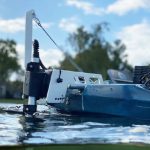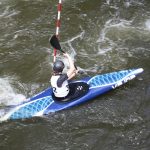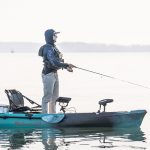Fishing from a motorized kayak offers many advantages. To get the best performance out of your trolling motor, you need to mount it properly.
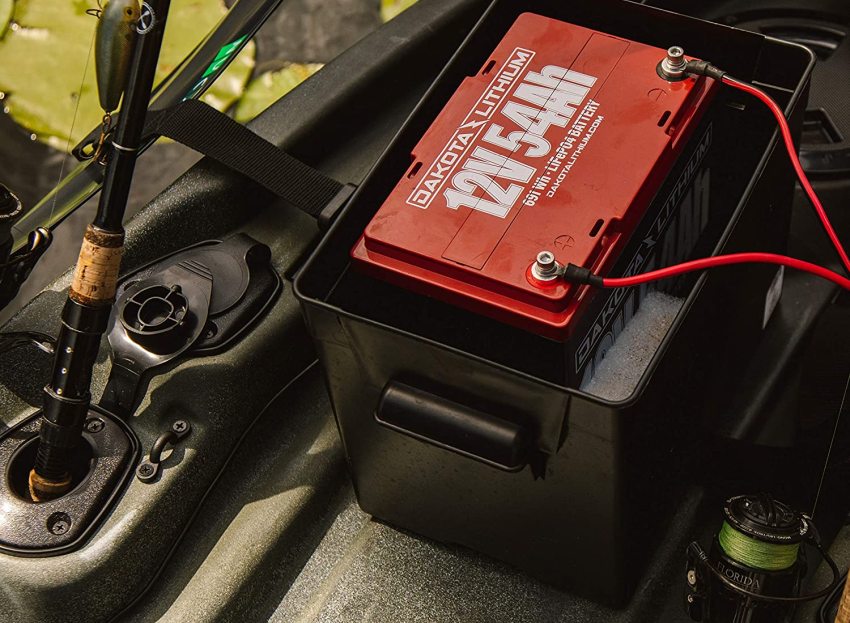
Adding a trolling motor onto your kayak is the perfect way to step up your fishing or hunting game!
With a motor, you can zip to and from your fishing or hunting spot, carry more gear, and spend more time out on the water with far less effort.
Really, it’s a game-changer that will make every paddling trip so much more enjoyable.
But it’s only possible if you have one critical piece of equipment: a trolling motor battery.
So, what’s the right battery for your trolling motor?
We’ve done all the research to bring you the best trolling motor batteries for your kayaking adventures. We’ve compared the pros, cons, features, specs, and operational capacities of the most popular products on the market.
Plus, we’ve got a complete guide to trolling motor batteries to help you learn everything you need to know.
So read on, and I guarantee you’ll find the right battery to keep your trolling motor running at full power!
As an affiliate of Amazon and other retailers, we may earn a small commission when you buy via our links, at no additional cost to you. Thank you!
Quick Answer: Best Trolling Motor Batteries
- Best Overall: Battle Born Batteries LiFePO4 Deep Cycle Battery
- Best Lightweight: Dakota Lithium LiFePO4 Deep Cycle Battery
- Best for Heavy Use: Ampere Time 12V 200Ah Lithium Iron LiFePO4 Deep Cycle Battery
- Best on a Budget: Weize 12V 35AH Deep Cycle AGM Battery
- Best Dual Purpose: Optima OPT8016-103 Batteries D34M
Comparison Table: Best Trolling Motor Batteries
| Model | Specs | Where to Buy |
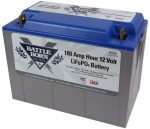 Battle Born Batteries LiFePO4 Deep Cycle Battery | Weight: 31 lbs. Dimensions: 12.75 x 6.88 x 9″ Materials: Lithium iron phosphate Capacity: 100 A continuous output | Amazon |
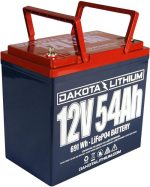 Dakota Lithium LiFePO4 Deep Cycle Battery | Weight: 18 lbs. Dimensions: 9.01 x 5.43 x 8.38″ Materials: Lithium iron phosphate Capacity: 54 Ah | Amazon |
 Ampere Time 12V 200Ah Lithium Iron LiFePO4 Deep Cycle Battery | Weight: 48.28 lbs. Dimensions: 20.5 x 9.37 x 8.54″ Materials: Lithium iron phosphate Capacity: 200 Ah | Amazon |
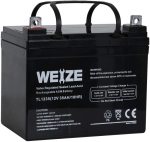 Weize 12V 35AH Deep Cycle AGM Battery | Weight: 23.1 lbs. Dimensions: 7.68 x 5.12 x 7.09″ Materials: Absorbent Glass Mat (AGM) Capacity: 35 Ah | Amazon |
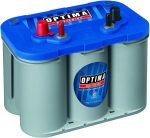 Optima OPT8016-103 Batteries D34M | Weight: 43.5 lbs. Dimensions: 10 x 6.88 x 7.8″ Materials: Lead acid wet-cell Capacity: 55 Ah | Amazon |
Top Rated Trolling Motor Batteries
Best Overall: Battle Born Batteries LiFePO4 Deep Cycle Battery
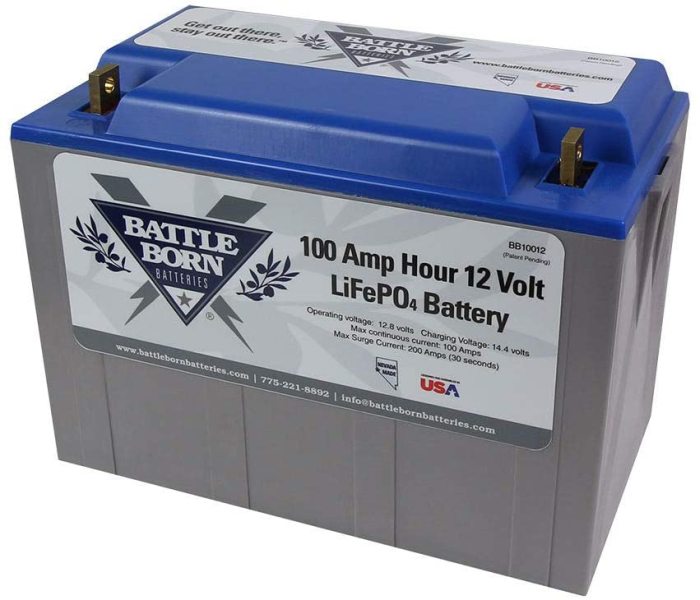
Weight: 31 lbs. (14 kg)
Dimensions: 12.75 x 6.88 x 9″ (32.3 x 17.5 x 22.9 cm)
Materials: Lithium iron phosphate
Capacity: 100 amp continuous output
Warranty: 10 years
Looking for a battery that’ll last longer and run harder? This beast of a lithium battery by Battle Born has the output of a 140lb lead acid battery, but weighs just 31 pounds and lasts up to 10 times longer.
The Battery Management System protects against ground faults and temperature volatility, regulates the power output, and serves as an auto-failsafe to switch off the battery in unsafe conditions. The battery is made using 100% non-toxic and renewable energy, designed to last more cycles, charge faster, and provide reliable power for your trolling motor.
It’s definitely on the pricier side, but guaranteed to be worth every penny!
Pros:
- 10-year warranty
- Made in the U.S.A.
- 200 amp surge output
- Versatile and durable
Cons:
- Expensive
- Some users complained about poor customer support
Best Lightweight: Dakota Lithium LiFePO4 Deep Cycle Battery
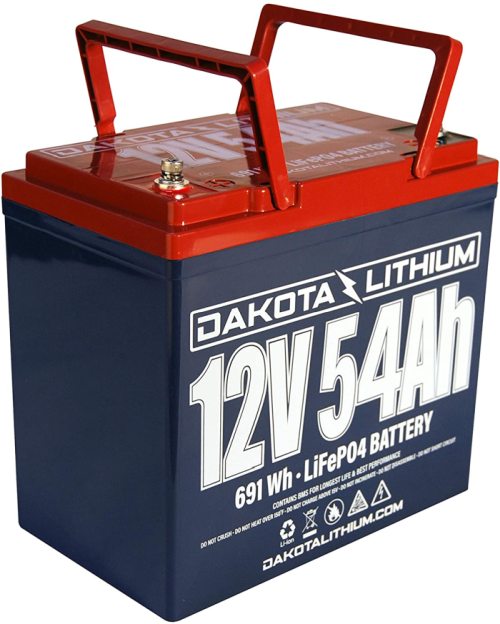
Weight: 18 lbs. (8.16 kg)
Dimensions: 9.01 x 5.43 x 8.38″ (22.9 x 12.7 x 21.9 cm)
Materials: Lithium iron phosphate
Capacity: 54 Amp-Hours
Warranty: 11 years
If you want to keep your gear as light as possible while still packing sufficient power, this is the battery for you! Clocking in at just under 18 pounds and 25% smaller than our top-rated battery pick, it’s a compact and beautifully lightweight option.
Yet it never sacrifices a shred of power. You still get a 54 Amp-Hour output, 2000+ charge cycles, 100% discharge, and active BMS that will balance the cells, cut off the power if the voltage drops too low, protect against short circuits, and shield the battery from temperature extremes.
It’s a battery built to last, made in the U.S.A. using only premium-quality materials. It’s got an longer-than-average lifespan and provides consistent power. You’ll find this delivers top performance as long as it has even a drop of energy. And when it runs out of juice, it’s designed to charge quickly so you can get back out on the water with minimal time spent waiting around.
Best of all, it’s fairly well-priced for a lithium battery!
Pros:
- Highly reliable
- Compact and beautifully lightweight
- US-made
- Minimal ghost discharge
- No maintenance required
Best for Heavy Use: Ampere Time 12V 200Ah Lithium Iron LiFePO4 Deep Cycle Battery
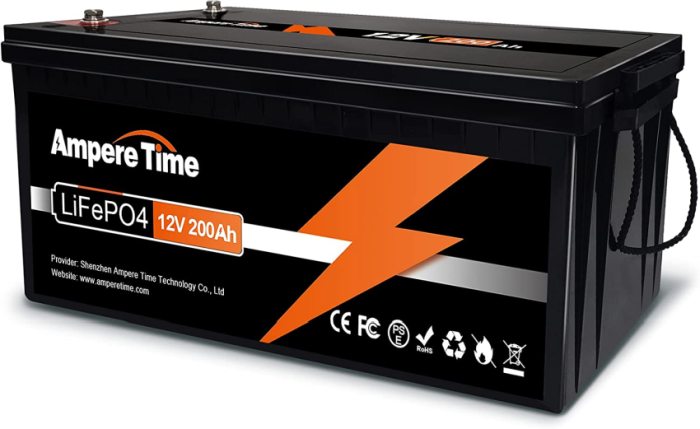
Weight: 48.28 lbs. (21.9 kg)
Dimensions: 20.5 x 9.37 x 8.54″ (52 x 23.8 x 21.7 cm)
Materials: Lithium iron phosphate
Capacity: 200 AH
Warranty: 5 years
For serious kayak anglers and competitive fishermen that spend all day out on the water, this is the heavy-duty battery you’ll need. With a run time of 200 Amp-Hours, it’s got more than enough power to keep your trolling motor operating for days at a time.
Let’s get one thing clear: it’s a HEAVY, chunky battery (nearly 50 pounds and 20+ inches long), so you’ll have to make sure it’s not too weighty for your kayak (including all your gear). However, if you need to keep your motor running all day during a tournament, you’ll find the 200 AH battery delivers maximum power and reliability.
The battery is expected to last between 4000 and 8000 recharges, is IP65 waterproof rated, and is designed to be both vibration-free and maintenance-free. The Professional BMS Board prevents overcharge, over-discharge, over-current, and short-circuit, and the automotive-grade LiFePO4 cells guarantee maximum safety and high energy density.
It’s certainly not the cheapest battery around and only has a 5-year warranty (to cover a projected 10-year lifespan), but if you want heavy-duty, it’s worth every penny.
Pros:
- Excellent power capacity and output
- Ultra-reliable
- 200 Amp-Hour runtime
- Waterproof
- Supports 1280W load power system
Cons:
- Heavy and bulky
- Expensive
Best on a Budget: Weize 12V 35AH Deep Cycle AGM Battery
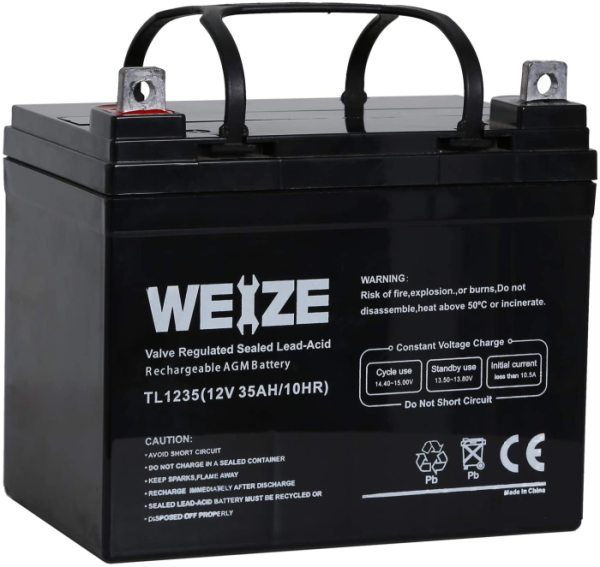
Weight: 23.1 lbs. (10.47 kg)
Dimensions: 7.68 x 5.12 x 7.09″ (19.5 x 13 x 18 cm)
Materials: Absorbent Glass Mat (AGM)
Capacity: 35 AH
Warranty: 1 year
If you’re trying to shop within a VERY limited budget, this Weize battery will run you just $80— 50-90% LESS than you’d pay for a lithium battery. Though it doesn’t have ultra-high output or capacity (just 35 Amp-Hours), it delivers reliable performance while it runs.
The fact that it’s an AGM battery means you’ll never have to worry about maintenance for as long as it lasts. The expected lifespan is around 3-4 years, with a warranty that covers just the first year. However, for the budget price, it’s an excellent option to get you started operating your trolling motor until you can pony up for the higher-cost, higher-performance lithium batteries.
You’ll love the fact that it’s incredibly compact (just over 7 inches long and tall) and weighs less than average, so it’ll easily fit into your kayak along with your gear. If you’ve got a lightweight trolling motor—the highly-recommended Watersnake T24 ASP, for example—it’ll be the ideal cheap battery to get you started.
Pros:
- Compatible with a wide range of small devices (home alarms, lighting equipment, electric scooters, solar collectors, etc.)
- Beautifully affordable
- Compact and fairly lightweight
- Works great for small trolling motors
Cons:
- Shorter lifespan than lithium batteries
- Can’t be returned after purchase
Best Dual Purpose: Optima OPT8016-103 Batteries D34M

Weight: 43.5 lbs. (19.73 kg)
Dimensions: 10 x 6.88 x 7.8″ (25.4 x 17.5 x 19.8 cm)
Materials: Lead acid wet-cell
Capacity: 55 Amp-Hours
Warranty: 3 years
Optima batteries are considered top-notch lead-acid wet-cell batteries. We rated Optima BlueTop as the “best dual purpose” because it doubles as both a deep-cycle marine battery and a suitable starting battery for your motorboat or RV.
The battery packs 55 Amp-Hours of power. With 870 Marine Cranking Amps, it has the power to start up even a larger fishing boat motor in rough waters. It’s built to withstand temperature extremes, comes in a waterproof case, and will hold its charge even after long periods of inactivity (during the winter months, for example). It performs very well in hot weather (over 90 F) and has a very low self-discharge rate. For the price, it’s definitely going to deliver above-average performance and is as reliable as you can expect from a wet-cell battery.
Pros:
- Compatible with low and high temperature use
- Supports fast-charging
- No leakage or water seepage
- Compact and fairly lightweight
- Excellent for trolling motor and motorboats alike
Cons:
- Very heavy
- Expensive for a lead acid battery
The Ultimate Guide to Trolling Motor Batteries
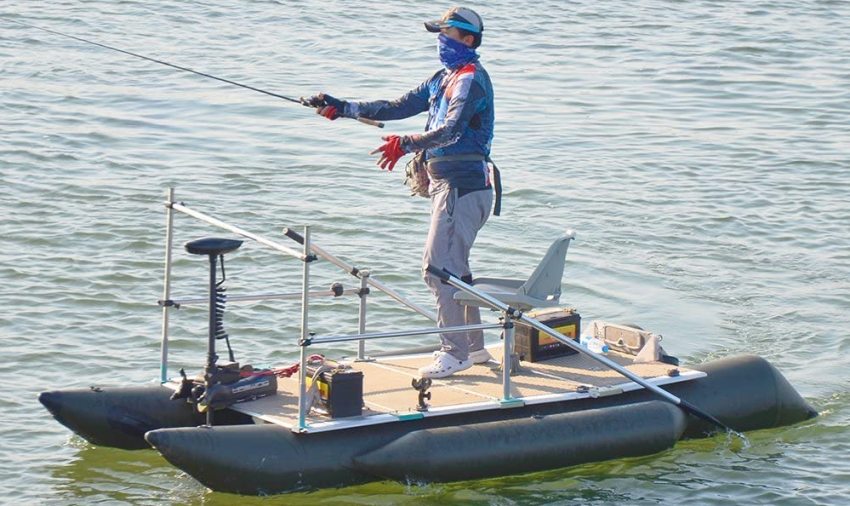
In this post, we’re going to talk about everything you need to know about trolling motor batteries: how they operate, what voltage you need, what factors to consider when battery-shopping, even some simple maintenance tips to help you maximize the lifespan of your battery.
Let’s start off with the most important element: the type of battery you want/need for your trolling motor.
Trolling Motor Battery Types
There are several types of trolling motor batteries:
Lead Acid Wet-Cell – Lead Acid Wet-Cell deep cycle batteries have been the “standard” for boat motors for the last few decades. They can handle a lot of draining and recharging, last for 2-3 years, and are typically on the more affordable side. However, they require regular maintenance (as simple as topping off the water in the battery) and may spill, leak, or vibrate excessively. They’re certainly the “budget” option, but not a top-of-the-line choice.
AGM – AGM, or Absorbed Glass Mat, batteries are fully sealed acid batteries packed with lead mats. They’re typically designed for use in a vehicle, but can be adapted (by manufacturers, not by you!) to serve as marine batteries for small motors. They require virtually no maintenance and will typically last 3-4 years, but they tend to be on the pricier side.
Lithium Iron – Lithium iron, or LiPoFe4, batteries are becoming more popular—not to mention significantly more affordable. They’re smaller and lighter than either of the other two battery types, last up to 10 years, and give you 100% depth of discharge (full power until the battery is totally drained, rather than a trickling decrease in power that occurs with lead-acid/AGM batteries). Lithium batteries also supply more power but take up far less space in your kayak.
As you can imagine, our top recommendations will all be lithium trolling motor batteries. They’re more durable, reliable, and longer-lasting. Best of all, they’re also becoming more affordable, to the point where they’re priced only slightly higher than other trolling motor batteries. I highly recommend spending a few bucks more and getting the better-quality battery every time!
Understanding Trolling Motor Battery Voltage
Most people find it pretty easy to understand the concept that “bigger motors = greater demand for power”.
Trolling motors can be powerful enough to require 36-volt batteries. However, trolling motors for kayaks are typically of the smaller size, usually generating between 18 and 55 pounds of thrust, and they will likely only need a 12-volt battery.
RELATED: 9 Best Motorized Kayaks in 2023: Your Guide to Motor Powered Fishing Kayaks (Electric and Gas)
Take note: most smaller trolling motors (of the sort typically used on a kayak) are designed specifically for a 12-volt battery. If you try to use a 24-volt battery on your 12-volt motor, you could overheat and burn out the motor’s internal components, wiring, and controller.
At the same time, trying to run a 24-volt trolling motor with a 12-volt battery can strain the motor, because it’s running at too-low voltage for its design. If you have a 24-volt trolling motor, you’ll want either two 12-volt batteries or one 24-volt battery to provide sufficient power.
Make sure to check the voltage on your trolling motor before shopping for a battery, and it’ll spare you from what could be easily avoidable damage!
Trolling Motor Battery Factors to Consider
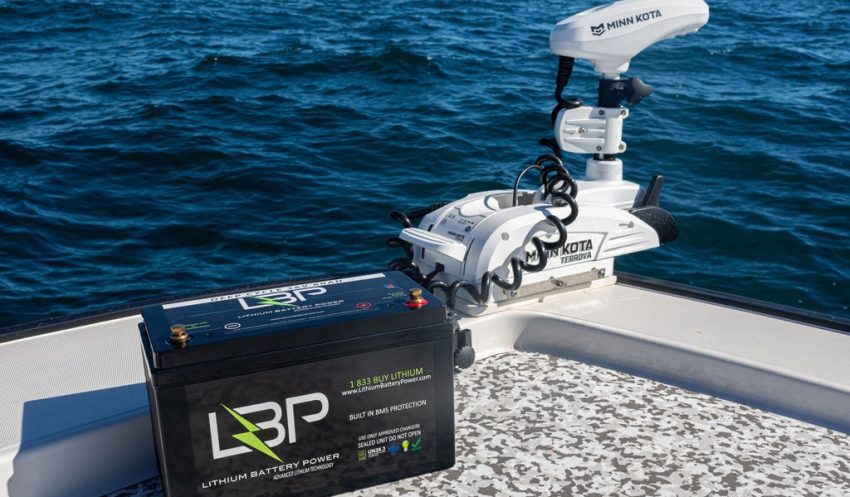
Aside from the voltage and battery type, there are a few other critical factors to consider when choosing a trolling motor battery:
Size – If you’re going to mount the motor onto your kayak, the battery also has to fit in the kayak. Typically fishing kayaks have open compartments large enough to accommodate a trolling motor battery, but it could take up space that you had intended for other fishing or hunting gear. Consider how you can organize your equipment to accommodate the added bulk of the battery you need to power your motor.
Weight – As you well know, adding too much weight into your kayak can not only slow it down, but also increase your risk of capsizing. One reason that we recommend lithium batteries is because they’re about 70% lighter than the standard deep-cycle batteries—which means they’re safer and less likely to cause you to tip over.
Output and Capacity – Every battery manufacturer has their own way of measuring and explaining their battery’s capacity and output levels. However, AH, or amp-hours, is most commonly used for deep-cycle batteries.
To get the AH rating, batteries are put through a 20-hour test to measure how fast the battery drains at 5 amps. A 50AH battery will last for 10 hours (10 hours x 5 amps per hour), while a 100 AH battery will last for 20 hours (20 hours x 5 amps per hour).
Other measurements include:
- Reserve capacity, or how long it takes a fully charged battery to drain below 10.5 volts discharging 25 amps at 80 degrees F.
- Hot cranking amps (HCA), or the number of amps a battery can implement at 80 degrees F for 30 seconds without dropping below 7.2 volts of power.
- Cold cranking amps (CCA), or the number of amps a battery can implement at 0 degrees F for 30 seconds without dropping below 7.2 volts of power. (This is a great measurement to calculate how effective a battery will be at cranking up a cold motor).
- Marine cranking amps (MCA), which is the same measurement as CCA, just used specifically on marine batteries.
Most of the time, you’ll just look at the Amp-Hour rating for the quickest and easiest way of telling what the battery output and capacity is. However, knowing these other terms is important if you want to do a deep dive into the exact specifications of the batteries you’re considering.
Run Time – Batteries come in “group sizes”. That term refers not only to the actual size but also the amount of amps they can generate per hour at 12 volts.
A group 24 battery delivers 70-85 amps per hour, a group 27 battery delivers 85-110 amps, while a group 31 battery delivers 95-125 amps. Obviously, the larger-sized batteries will take up more space in your kayak and weigh more, but they can deliver a longer runtime. It may be worth the tradeoff if you’re heading to a faraway fishing or hunting spot and need your trolling motor to run longer.
Lifespan – Both lead acid wet-cell and AGM batteries will become less and less powerful as they drain, so they’ll generate less energy the lower their voltage drops. They also become less effective at holding power with every re-charge. Their lifespan is 2-4 years, and eventually they’ll just stop charging effectively altogether. That’s when it’s time to replace them.
Lithium batteries, on the other hand, have a 10-year lifespan, and they will always hold 100% charge no matter how many times you recharge them. However, they’re only capable of a certain number of charges (500, 1000, 1500, etc.) and then they just will stop charging completely.
Warranty – You ALWAYS want to make sure your trolling motor battery is backed by a good warranty. The last thing you want is to have to buy a new battery after just a few months because the product you received was defective but didn’t include a warranty to guarantee replacement.
The best lithium batteries typically have a longer warranty—in the case of our top pick, 10 years—while AGM and lead acid wet-cell batteries usually have a warranty ranging from 2-3 months to 2-3 years, depending on their expected lifespan.
Charger – A good charger is just as important as a good battery. After all, you can’t use the battery more than once if you have no way to recharge it, right?
Some chargers are merely designed to be connected to a power source (like a wall socket or 12-volt charging port in your car) to top up a drained battery.
However, there are some marine battery chargers that also work as onboard chargers, providing an extra boost of power from a built-in battery bank. These can be very useful if you run out of juice and need to recharge your battery out on the water. You may not get a full charge, but just enough to get you back to shore where you can plug the charger into a power source to recharge both it and the trolling motor battery.
Durability – Lithium batteries are the most durable on the market, with the longest lifespan and the lowest risk of malfunction or damage. AGM batteries are equally durable, thanks to their fully sealed casing that reduces leakage, vibration, or shock. Lead-acid wet-cell batteries, however, may leak, spill, or vibrate excessively. They’re also less durable and more prone to maintenance issues.
You’ll pay more for a lithium battery, but it’s worth the extra expense because A) it’s less prone to issues than a lead acid wet-cell battery, and B) its lifespan is significantly longer than the equally-durable AGM batteries.
Maintenance – As I mentioned above, wet cell batteries need occasional maintenance. Typically, you’ll need to refill the battery (using filtered water), and it’s not uncommon for the batteries to show signs of corrosion that require cleaning. If you want a totally maintenance-free battery, you’re better off with the slightly pricier lithium battery.
However, wet cell batteries are a reasonable option for anyone who doesn’t mind doing a bit of maintenance and would rather stick with the budget choice to keep their kayak upgrades as cheap as possible.
Waterproofing – This is absolutely critical! If saltwater or lake water seeps into your battery, it could damage it and shorten its lifespan significantly.
Most marine batteries are built with some form of waterproof exterior housing, shell, or case, with specially metal-coated terminals that won’t be damaged by exposure to water. However, it’s always worth reading reviews to make sure the battery is fully waterproof before you buy it and take it out into the middle of the lake, ocean, or river.
Price – Though not the most important factor, price is always a consideration, especially for kayakers who are upgrading on a limited budget.
Lead acid wet-cell batteries are the cheapest. They still may be a decent choice if you want to upgrade your kayak TODAY but are a bit “tapped out” because you also bought the trolling motor, mounting hardware, and other necessary equipment.
But if you can afford to pay a bit more, I highly recommend a lithium battery because it’s the most durable, reliable, and long-lasting of the trolling battery types. It’s a long-term investment that will give you many more years of trolling motor use!
Trolling Motor Battery Maintenance Tips
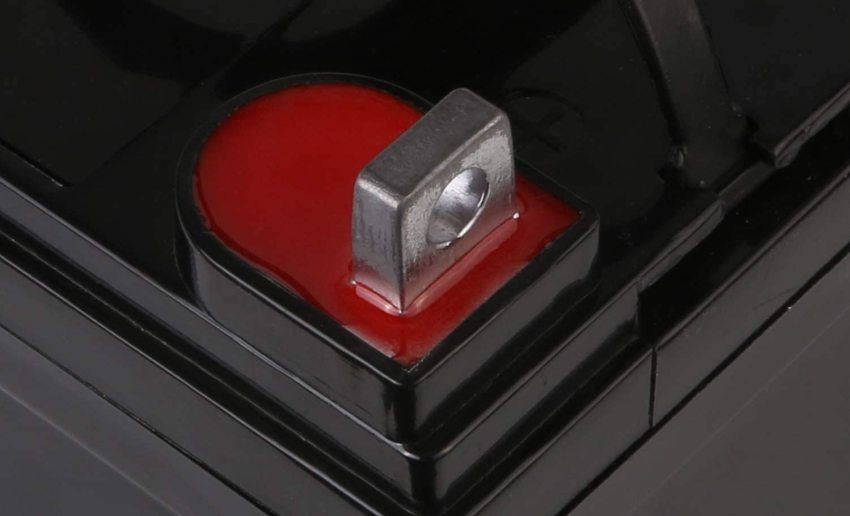
Keep your trolling motor battery in tip-top shape by:
Charging to 100% on your first use. When you first get the battery, charge it to full with no pauses or breaks. Manufacturers tend to test the batteries before selling them, but you want to make absolutely certain the battery actually can be charged to 100%–otherwise you’ll need to get a replacement!
Always charging to 100%. Under-charging your battery can lead to gassing and stratification (damage) of the battery’s internal components.
Maintaining it above 80% charge. This helps to maintain the battery’s longevity and keeps it topped up and ready for use at any moment.
Never storing the battery discharged. Storing a “dead” (discharged) battery will also affect its lifespan and potentially reduce its capacity and output both.
Protecting it from extreme temperatures—both freezing and high heat can affect battery performance. Temperatures above 80 F and below 0 F can affect its performance and shorten its lifespan. During cold winters and hot summers, store it inside your heated/air-conditioned house.
Watering your wet-cell battery regularly. If you choose a wet-cell battery, regularly top it up with filtered water to make sure it operates at optimum capacity.
FAQs
Absolutely not! Not only are car batteries NOT fully waterproof (you know how dangerous that can be), but they function differently than marine batteries. Car batteries are designed to put out a huge current for a very short period of time (to start the car) and are then recharged by the motor, while deep-cycle batteries used for trolling motors deliver modest current output for longer periods. Using a car battery for a trolling motor will ruin the battery.
As soon as possible following every use, and always to 100%! This is the best way to maintain the battery and protect its lifespan.
The battery run time will depend on A) the battery’s Amp-Hour rating (the higher the AH, the longer the run time) and B) the motor’s thrust-pound rating (the higher the thrust-pounds, the more power needed to run it.

